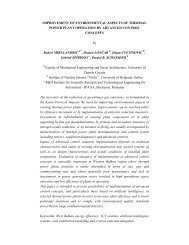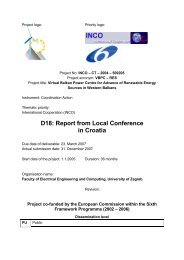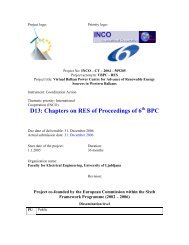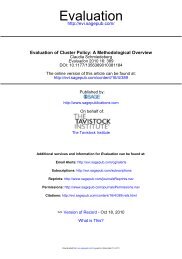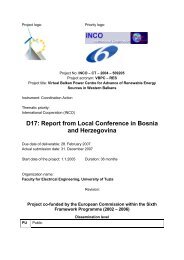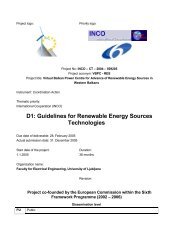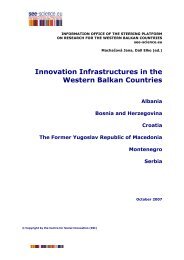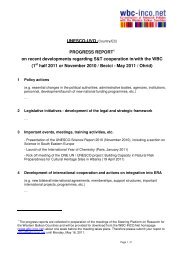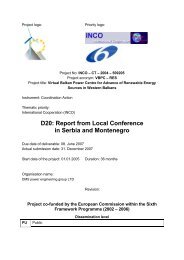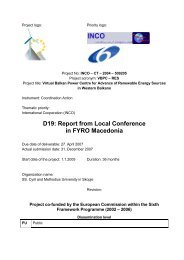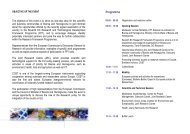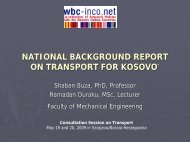National Profile
National Profile
National Profile
You also want an ePaper? Increase the reach of your titles
YUMPU automatically turns print PDFs into web optimized ePapers that Google loves.
30 positively at cloud computing, but 41% of 2010. The immedia technologies and services, and on the other hand,<br />
management of the waste cycle”, technological innova- distributed on a conveyor belt in a single layer. When hit 31<br />
Italy<br />
NOMADIc ENVIRONMENTS<br />
Cloud computing is mainly used by the small and medium<br />
Italian enterprises and with a rate slightly lower<br />
than the European enterprises (Italy:55%, Europe:60%).<br />
There is still certain reluctance towards this technology,<br />
mainly due to problems related to safety and privacy, for<br />
budget problems, but above all due to the absence of a<br />
strong infrastructure, able to guarantee an adequate broadband<br />
connection. The sector, however, will show strong<br />
expansion in the near future. The smart phones penetration<br />
is very high, Italy has the highest number of users of<br />
these devices (Italy: 15 millions, UK:1, Spain: 10, Germany:<br />
8.5, France: 7).<br />
60 % of Italian SMEs use cloud computing for data storage<br />
or for e-mail services, 40% of SMEs have transferred the<br />
Office applications, 33% also the computing resources and<br />
27% the desk computing. The rate of the interest is significantly<br />
growing, in 2009 only 12% of companies looked<br />
portance of this sector lies in the big competitiveness that<br />
cloud computing can give, thanks to the reduction of the<br />
PuBLIc TRANSPORT<br />
The situation of transport infrastructures in Italy<br />
is characterized by a contrast between the North<br />
with comfortable and modern highways, railways,<br />
airports etc. and the South with undeveloped areas. A<br />
common characteristic is the high prevalence of private<br />
cars.<br />
Public transport in Italy is used by a low percentage<br />
of the population that complains about the low flexibility<br />
of the service and the low speed of the means<br />
(average of 18.6 Km/h), to the point that Italians are<br />
the most unsatisfied in Europe.<br />
The Italian public transport system is inadequate the<br />
following reasons:<br />
Lack of preferential lanes for buses inside the urban<br />
road network<br />
Lack of interchange parking<br />
Undeveloped of the subway network<br />
The shortage of the subway networks in the Italian<br />
cities is obvious in comparison with other major European<br />
ones: Milan (84 Km), Rome (36.5 Km) Naples<br />
(28 Km) London (408 Km), Madrid (296 Km), Paris (213<br />
Km), Berlin (144 Km), Barcelona (107 Km), Munich<br />
(101 Km) etc.<br />
WASTE MANAgEMENT<br />
The Italian situation is in line with the European average<br />
(MSW: 550 Kg per capita, per year) accounting<br />
to 32 millions of tons yearly, of which only 8.8 millions<br />
are recycled (27.5%), but with evident geographical variations<br />
(North: 42.4%, Centrum: 20.8%, South: 11.6%).<br />
In Italy there are 5884 recovery plants of non-dangerous<br />
wastes, of which 4102 in the North, 1005 in the Centrum,<br />
costs of hardware infrastructures, to scalability of the demand<br />
and to the frequency of the software updating.<br />
Italian managers have a good predisposition to technologies<br />
(a proof is the high rate of virtualization). This fact,<br />
together with the potential offered by the cloud (above all<br />
to obtain savings in a medium term) and by the high penetration<br />
of smart phones, guarantees a good potential for<br />
growth for this application area. An important prerequisite<br />
is the enhancement of penetration, reliability and speed<br />
of the broadband on the country.<br />
A great potential for Italy is the possibility of exploiting<br />
ubiquitous environment for tourism to find use of huge<br />
artistic, religious and archaeological heritage. Some examples<br />
may be, on the one hand, innovative guidance<br />
services and touristic info, given to tourists through smart<br />
phones, Wi-Fi points, Bluetooth and other useful multi-<br />
some virtual reality services, such as the reconstruction of<br />
ancient places.<br />
There is also a deficiency of initiatives for the revival<br />
of the use of bicycles that require an adequate network<br />
of bicycle paths, bike sharing systems etc.<br />
The benefits obtainable through a valid and efficient<br />
public transport service are the following:<br />
Environmental benefits (reduction of emissions,<br />
reduction of noise, increase of zones free from the<br />
obstruction of cars etc.)<br />
Social benefits (increase of road safety and reduction<br />
of accidents)<br />
Economic benefits (reduction of fuel consumption,<br />
reduction of parking costs etc.).<br />
Increase of a number of clean vehicles, additional information<br />
services (waiting times), alternative paths,<br />
interchange parking, transports on-demand, mobility<br />
management measures, promotion activities, are<br />
all issues to work on, in order to provide users with a<br />
competitive service. Specifically, it would be necessary<br />
improve the infrastructural situation (subways lines,<br />
enhancement of preferential lanes, bicycle paths etc.)<br />
but it would also be necessary to intervene with purely<br />
technological and innovative measures that would<br />
have various objectives: eco-friendly, higher automation,<br />
informative systems and safety systems etc.<br />
and only 777 in the South. This underlines the strong gap<br />
existing between the North and the South of the country.<br />
The levels of recycling collection are lower than the ones<br />
of the major European countries. From 2003 to 2007 it<br />
has been recorded a reduction of landfilling from 53.5%<br />
to 46.7%, but, at the same time, an increase of the incineration<br />
(in 2007 more than 3.9 millions of tons incine-<br />
rated, equal to 12%). The production of special wastes<br />
is growing: 72 millions of tons of non-dangerous, 9.2 of<br />
dangerous and 52 coming from construction and demolition<br />
activities. In general, 47% of waste is disposed in<br />
landfills, 10% is incinerated, 23% subjected to a biologic/<br />
mechanical treatment and the remaining 20% to other<br />
treatment. It must not noted that, in some regions, the<br />
waste disposal is an activity that has relevant infiltrations<br />
of organized crime, that has set up a considerable<br />
business through the abusive disposal, causing huge environmental<br />
damages. This makes the situation, in these<br />
areas, very delicate and needs policy initiatives to fight<br />
against these criminal activities, more than technological<br />
or procedural interventions.<br />
The separating, composting and recycling of wastes is a<br />
more sustainable approach than the traditional disposal,<br />
because reduces the environmental and health impacts,<br />
reduces the management costs and can create new jobs.<br />
In the scope of an overall development of an “integrated<br />
tion plays a primary role. The research of new technical<br />
and scientific solutions allows to implement a set of strategies<br />
aiming at recovering and reusing wastes, reducing<br />
the quantity intended to landfilling and, moreover, allowing<br />
to upgrade the industrial productive processes with<br />
the aim of a higher overall level of eco-sustainability.<br />
The definition of new and innovative systems to manage<br />
waste at household level, systems able to facilitate the se-<br />
EMBEDDED SYSTEMS IN AgRIcuLTuRE<br />
Even if, nowadays, this field employs just 5% of the active<br />
population, agriculture in Italy is one of the most<br />
important in Europe. Italy is among the first countries in<br />
Europe in production of wheat, rice and corn. wine and<br />
olive oil production are well developed. In general Italian<br />
agriculture consists of two types: an intensive one, modern<br />
and very productive (in the Po Valley, in plain Metapontina<br />
etc.) and one , widely scattered, more extensive<br />
and less modern, where the component of tradition is<br />
still dominant and where the technological component<br />
is barely present.<br />
A great development is having bio-production, where Italy<br />
is the leader in Europe with a production that affects<br />
approximately 6.9% of agricultural land. However, the<br />
Italian agricultural entrepreneurial world is reluctant to<br />
invest in new technologies, sometimes preferring cheap<br />
labour made up by migrants from North Africa.<br />
The agricultural sector despite of the excellence and<br />
high specialization achieved, represents a minimal<br />
percentage of the national economy. It must be noted<br />
that having a predominantly mountainous shape, Italy<br />
is not very suitable for agriculture, As of 2009 Italy in<br />
this sector employs a workforce of approximately 1.05<br />
million people.<br />
Italy stands out, at a European level, for the production<br />
of cereals such as wheat (8,951,590 tons), corn<br />
(9,789,401 tonnes) and rice (1,388,927 tonnes, the largest<br />
producer in EU) soybeans (353,761 tons) and sugar<br />
paration and the collection, systems for the traceability<br />
of wastes, systems useful to simplify the operations of<br />
decoupling of material laminated, technological systems<br />
for reduction of pollutants of energy plants, etc.<br />
An example of innovation is SISTRI - an initiative of the<br />
Ministry of Environment that allows tracing special waste<br />
in a telematic way, because of the system specifically<br />
developed for this goal. Another example is THOR (Total<br />
House Waste Recycling) that is a technology developed<br />
by CNR (<strong>National</strong> Research Council) and by a private<br />
company for the mechanical treatment of waste and for<br />
fuel from waste production (powder). It is based on a<br />
process of cold refining of the undifferentiated material.<br />
In short, it is a system that allows to recover and refine<br />
waste and turn it into an indistinct homogeneous mush,<br />
purified by the harmful parties and that can be used as<br />
fuel by the high calorific value, bypassing the differentiated<br />
collection. Yet another example is the "infrared<br />
spectrograph". The scraps of paper or plastic are usually<br />
by the beam of light from a halogen lamp, any material<br />
reflects a specific colour scheme that allows to identify it.<br />
Therefore, a jet including the air separates from the rest.<br />
This system allows separating various types of materials<br />
with accuracy close to 98%. In short we can say that<br />
the fields of application of new technologies are indeed<br />
many.<br />
beet (3,845,791tons), all grown mainly in the North.<br />
Italy together with France is the world leader in wine<br />
production and is second only to Spain in the olive oil<br />
production. The South is specialized in the cultivation of<br />
vegetables (tomatoes, lettuce, fennel, peppers, cauliflower,<br />
celery).<br />
The lack of work in Italy is a question that plagues much<br />
of youth, which sees agriculture as a backward and disparaging<br />
sector, not as a possible job opportunity. The<br />
raising of the technological and innovative level in this<br />
sector could provide a reassessment of agricultural activity,<br />
providing new job opportunities. This is particularly<br />
valid in the southern part of the country, which<br />
has a centuries-old tradition of farming and herding, and<br />
where food and wine productions have especially high<br />
levels. However, this system should be revised from a<br />
more modern point of view, concerning marketing and<br />
promotion.<br />
Italy has certainly a high potential for growth and innovation<br />
in the food industry, given its tradition and the<br />
international reputation of its products. The geography<br />
(long and narrow, mostly mountainous) benefits a modern,<br />
more intensive agriculture, which is achievable<br />
only with a change of mentality concerning the small farmers,<br />
that must adopt an approach based on innovation<br />
and technology, with a more entrepreneurial thinking.<br />
Italy



